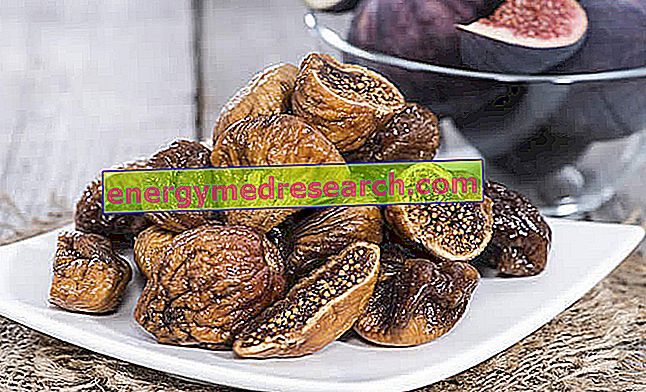What are?
Dried figs are foods of vegetable origin obtained by processing the fruits of the tree commonly called "fig"; this plant belongs to the Specic Ficus carica, of which several varieties differ.
It should be pointed out that what we have just called fig fruit is actually a large infructescence called siconius; the true fruits of the fig grow inside this infructescence and are commonly called seeds (in reality they are achenes, dry fruits inside which the seed is enclosed).

Figs are classified in the VI-VII group of foods although, like the other preserved fruits, the dried ones do not present all the peculiar characteristics of this whole. In the next chapter we will understand why.
Dried figs are obtained by dehydration; this process, typical of many other preserved foods (dried prunes, dried apricots, dried tomatoes, dried meat, dried cod, bottarga, aged cheeses, etc.), in this specific case is obtained ONLY thanks to ventilation and / or heat (tenuous). Therefore, it is possible to obtain dried figs also by means of a good ventilated oven, avoiding the addition of osmotic chemical elements (generally sugar and / or salt) which, although favoring this process, tend to significantly modify the nutritional characteristics of the food .
There are various types of dried figs, different for: fig variety, drying method, presence of other ingredients, use of additives (antioxidants, preservatives) etc. In addition to the simple ones, there are dried figs covered with chocolate, dried figs filled with almonds, glazed dried figs (sugar or honey), dried figs in spirit, etc.
Nutritional Features
WARNING! Below we will comment only on the nutritional properties of simple dried figs, not those glazed or almond or chocolate, etc; some of these, however, are mentioned in the summary table.
As anticipated, the dried figs should belong to the VI-VII food group. However, these are not fresh fruits; therefore, they do not have all the features necessary to fall into the category.
Dried figs have a very high energy supply, supplied mainly by carbohydrates (high glycemic load); on the contrary, proteins and lipids appear in marginal quantities. The considerable caloric density of dried figs precludes its use in the diet against overweight.
Dried fig carbohydrates are simple and mainly composed of fructose (low glycemic index monosaccharide); the peptides are of low biological value and the predominantly unsaturated fatty acids (above all polyunsaturated). Among the latter also include certain essential nutrients of the omega 3 and omega 6 group, which are beneficial for lipid metabolism and blood pressure; the lipid component is however enclosed within the "seeds" which, if not chewed, pass through the intestine and are expelled.
Dried figs are also very rich in fiber, which contribute to reducing the glycemic index of the food which, however, is of medium size. Considering that both the speed of glycemic growth (glycemic index), and the maximum peak of glycemia (glycemic load), are responsible for stimulating insulin, it is possible to establish that dried figs are NOT suitable for the nutrition of people suffering from certain metabolic impairments. These include hyperglycemia (or established type 2 diabetes mellitus) and hypertriglyceridemia, often related to each other.
The dietary fibers of dried figs also contribute to the maintenance of a good intestinal function, preventing constipation and feeding the physiological bacterial flora (prebiotic function). It should however be specified that, in order to obtain a laxative effect, it is essential to combine dried figs with abundant quantities of water, without which one runs the risk of obtaining the opposite effect.
Dried figs, being rich in seeds, should be excluded from the preventive diet for diverticulitis.
As far as mineral salts are concerned, dried figs are rich above all in potassium (useful for sportsmen and not only) but also abound in calcium and phosphorus (necessary for the correct development and maintenance of bone mass); discrete iron intake (probably not very bioavailable).
With regard to vitamins, a good content of thiamine (vit B1) and retinol equivalent is shown (pro vit A).
Dried figs are suitable for gluten and / or lactose intolerant diets; furthermore, they do not present any ethical-religious complications (vegetarians, vegans, Muslims, Jews, Hindus, etc.).
The average portion of dried figs is about 40g (100kcal), or about 4 units (10g each).
Some dried figs, especially commercial ones, contain food additives such as sulfur dioxide.
| Chemical composition | Nutritional value per 100g of food | |||
| Dried figs | Figs, oven dried and almond cakes | Figs, Dried in stew | ||
| Edible part | 100% | 100% | 100% | |
| water | 19, 4g | 18, 3g | 69, 8g | |
| Protein | 3.5g | 5, 2g | 0.3g | |
| Total lipids | 2.4 g | 4, 2g | 0, 28g | |
| Saturated fatty acids | 0, 54g | - g | 0, 06g | |
| Monounsaturated fatty acids | 0, 60g | - g | 0, 07g | |
| Polyunsaturated fatty acids | 1, 29g | - g | 0, 15 g | |
| Cholesterol | 0, 0mg | 0, 0mg | 0, 0mg | |
| Carbohydrates available | 58, 0g | 58, 2g | 27.6 grams | |
| Starch | 0.0g | 0.0g | 0.0g | |
| Soluble sugars | 58, 0g | 58, 2g | 27.6 grams | |
| Total fiber | 10.4g | 14, 0g | 4, 2g | |
| Soluble fiber | - g | - g | - g | |
| Insoluble fiber | - g | - g | - g | |
| Phytic acid | 0.4g | - g | - g | |
| Alcohol | 0.0g | 0.0g | 0.0g | |
| Power | 253, 1kcal | 277, 0kcal | 107, 2kcal | |
| Sodium | 87, 0mg | - mg | 4, 0mg | |
| Potassium | 1010, 0mg | - mg | 294, 0mg | |
| Iron | 3, 0mg | - mg | 0, 9mg | |
| Football | 186, 0mg | - mg | 70, 0mg | |
| Phosphorus | 111, 0mg | - mg | 29, 0mg | |
| Magnesium | - mg | - mg | - mg | |
| Zinc | 0, 9mg | - mg | 0.2mg | |
| Copper | - mg | - mg | - mg | |
| Selenium | - µg | - µg | - µg | |
| Thiamine | 0, 14mg | - mg | 0.01mg | |
| Riboflavin | 0, 10mg | - mg | 0, 11mg | |
| Niacin | 0, 60mg | - mg | 0, 64mg | |
| Vitamin A retinol eq. | 80, 0μg | - µg | 0, 0μg | |
| C vitamin | - mg | 0, 0mg | 4, 40mg | |
| Vitamin E | 0, 0mg | - mg | 0.15 mg | |
Ricotta-stuffed figs
X Problems with video playback? Reload from YouTube Go to Video Page Go to Video Recipes Section Watch the video on youtube



